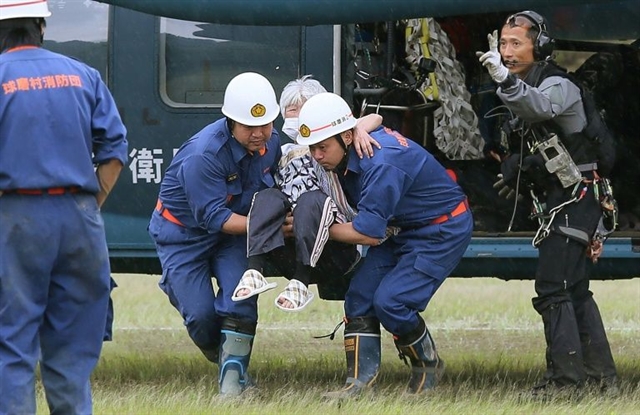 World
World


|
| Rescue has only been possible by helicopter in many cases. — AFP/VNA Photo |
YATSUSHIRO — Emergency services in western Japan were "racing against time" on Tuesday to rescue people stranded by devastating floods and landslides, with at least 50 feared dead and more torrential rain forecast.
Japan's Meteorological Agency issued its highest emergency warning level for heavy rain and landslides over vast swathes of the southwestern Kyushu island, with downpours expected until Thursday.
The death toll from the heavy rains that started in the early hours of Saturday is expected to climb. An official in the hardest-hit region of Kumamoto said that 49 were now confirmed dead with one other feared dead.
"We are racing against time," Yutaro Hamasaki, a Kumamoto official, said early Tuesday morning.
"We have not set any deadline or time to end the operation, but we really need to speed up our search as time is running out. We won't give up to the end," Hamasaki vowed.
More than 40,000 personnel, including police and firefighters as well as coast guards and troops, were deployed to rescue people, with around a dozen still unaccounted for.
Rivers overflowing their banks have swept away bridges and turned roads into lakes, making rescue access possible only by raft or helicopter.
Nobuko Murakami, a 78-year-old woman whose house was destroyed by landslides, told local media: "I couldn't sleep as the sound of the rain was deafening. I have lived here for more than 50 years, but I have never seen such heavy rain. I wonder when I can get back home."
Kentaro Oishi, who owns a rafting business in the hot springs resort of Hitoyoshi City, said that the emergency services called him for help and he had swapped tourists for stranded locals.
"I have 20 years of rafting experience, but I never dreamed" of rowing the boat through the city, the veteran paddler said.
"To tell you the truth, I was so scared at first when I saw the water levels rising so rapidly in the river," he said.
'Filled with water'
Fourteen of the dead were wheelchair-bound residents of a nursing home unable to escape to higher ground as the waters rose.
A rescue worker who searched the facility told NHK: "The ground floor was filled with water and we couldn't get into it. Some people managed to evacuate to the first floor. I've never experienced anything like this in my life."
Further complicating the evacuation efforts was the fear of spreading the coronavirus.
Compared to many other nations, Japan has been relatively lightly affected by the pandemic, with just under 20,000 cases and fewer than 1,000 deaths.
But the need to maintain social distancing has reduced capacity at evacuation shelters with hundreds of thousands of people under non-compulsory orders to take refuge.
In Yatsushiro city, authorities converted the local sports gymnasium into a shelter, with families separated off by cardboard walls to prevent the spread of the virus.
According to local media, some people were preferring to sleep in their cars rather than risk possible infection at a shelter.
For some local business owners already battered by the coronavirus crisis, the natural disaster has compounded their problems.
Yuji Hashimoto, who runs a tourism bureau in the hot-spring resort in Yatsushiro, one of the flood-hit cities in Kumamoto, said that the "beautiful tourism spot dramatically changed overnight".
"The damage was beyond our imagination. It's literally a bolt from the blue... The disaster is a double-whammy as our hot spring resort was struggling to weather the impact of coronavirus. We don't know what will happen to us next," he said.
Japan is in the middle of its annual rainy season, which frequently unleashes deadly floods and landslides.
Climate change is also playing a role because a warmer atmosphere holds more water, increasing the risk and intensity of flooding from extreme rainfall.
In 2018, more than 200 people died in devastating floods in the same region of Japan. — AFP




